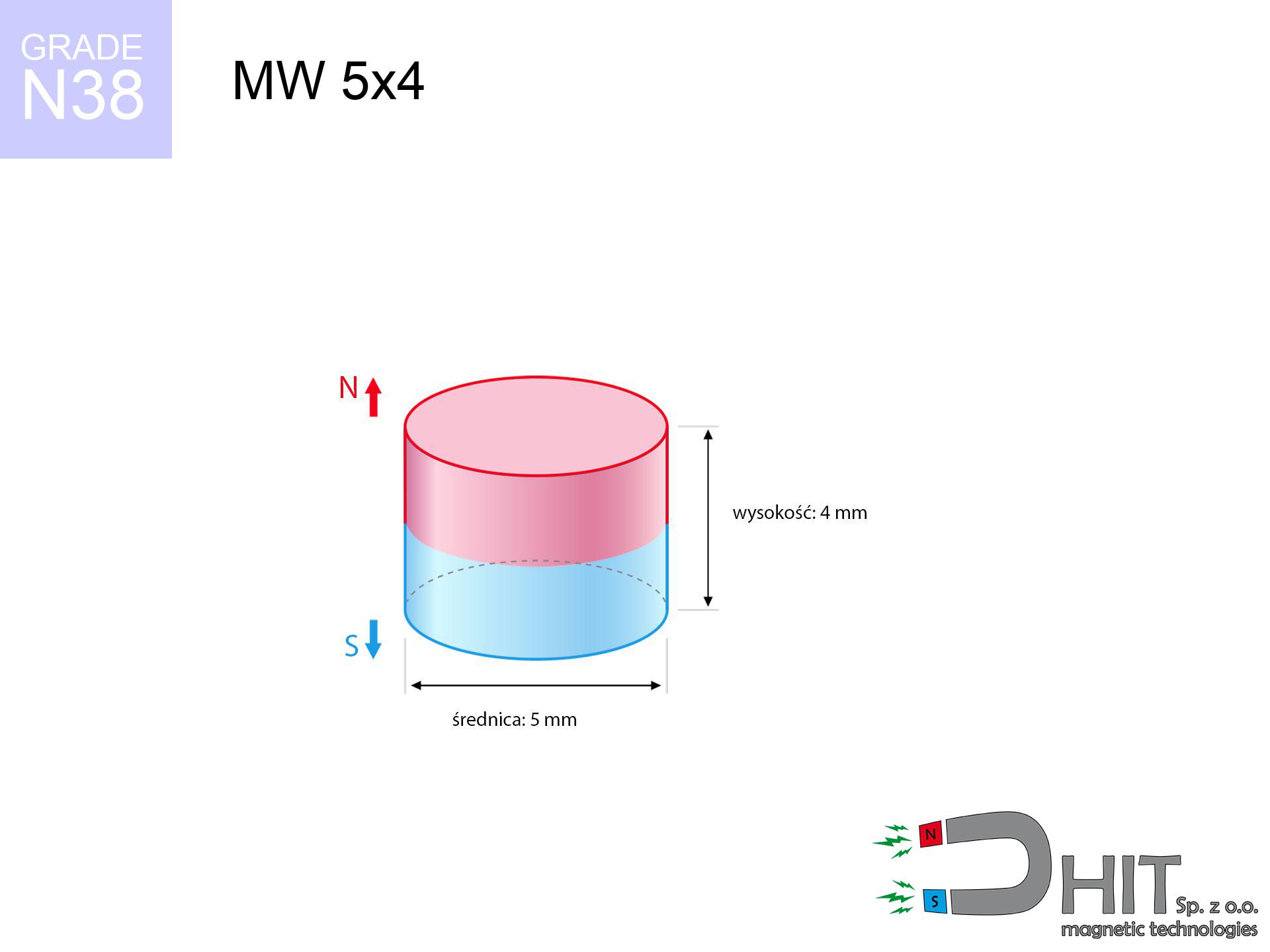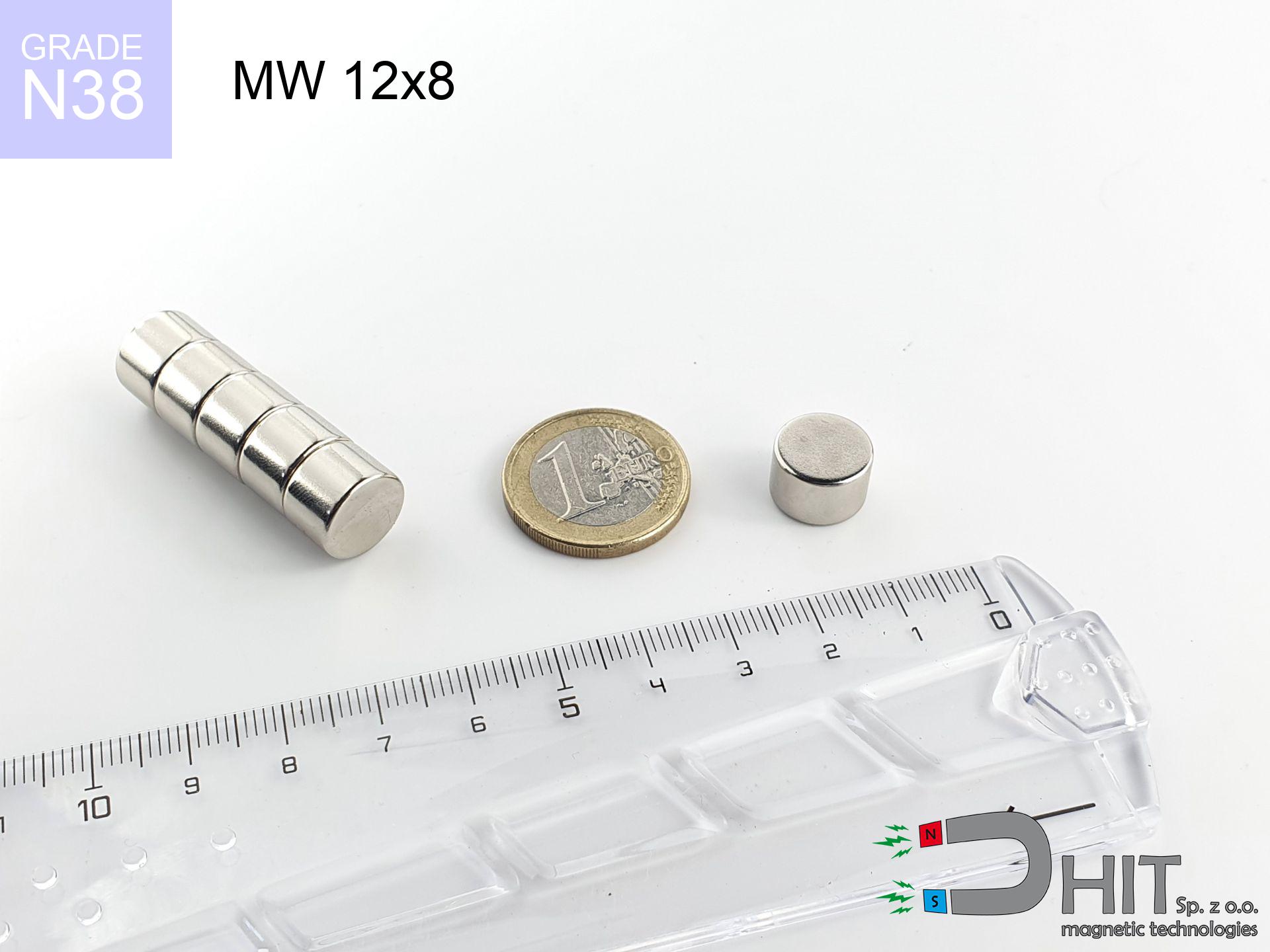MW 5x4 / N38 - cylindrical magnet
cylindrical magnet
Catalog no 010089
GTIN: 5906301810889
Diameter Ø [±0,1 mm]
5 mm
Height [±0,1 mm]
4 mm
Weight
0.59 g
Magnetization Direction
↑ axial
Load capacity
1.11 kg / 10.89 N
Magnetic Induction
524.45 mT
Coating
[NiCuNi] nickel
0.34 ZŁ with VAT / pcs + price for transport
0.28 ZŁ net + 23% VAT / pcs
bulk discounts:
Need more?Want to talk magnets?
Call us now
+48 22 499 98 98
if you prefer get in touch via
our online form
the contact page.
Lifting power and form of neodymium magnets can be estimated on our
our magnetic calculator.
Same-day processing for orders placed before 14:00.
MW 5x4 / N38 - cylindrical magnet
Magnetic properties of material N38
Physical properties of NdFeB
Shopping tips
Moreover, although neodymium is part of the strongest magnets, they are prone to corrosion in humid environments. Therefore, they are coated with a coating of gold-nickel to increase their durability. It's worth noting that NdFeB neodymium magnets are about 13% lighter than SmCo magnets and, despite their power, are brittle, which requires special caution during their handling. Therefore, any mechanical processing should be done before they are magnetized.
In terms of safety, there are many recommendations regarding the use of these magnets. It is advisable to avoid their use in acidic, basic, organic environments or where solvents are present, and also in water or oil. Additionally, they can distort data on magnetic cards and hard drives, although data deletion using a neodymium magnet is not guaranteed.
In terms of properties in different environments, neodymium magnets are susceptible to corrosion, especially in humid conditions. Therefore, they are often coated with thin coatings, such as gold, to preserve them from environmental factors and extend their lifespan. Temperatures exceeding 130°C can cause a loss of their magnetic properties, although there are specific types of neodymium magnets that can withstand temperatures up to 230°C.
As for risks, it is important to avoid using neodymium magnets in acidic environments, basic conditions, organic or solvent environments, unless they are insulated. Additionally, their use is not recommended in wet conditions, oil, or in an atmosphere containing hydrogen, as they may lose their magnetic properties.
Advantages as well as disadvantages of neodymium magnets NdFeB.
Apart from their strong holding force, neodymium magnets have these key benefits:
- They retain their magnetic properties for almost 10 years – the drop is just ~1% (based on simulations),
- They protect against demagnetization induced by external magnetic fields very well,
- Because of the lustrous layer of silver, the component looks high-end,
- They possess strong magnetic force measurable at the magnet’s surface,
- Neodymium magnets are known for very high magnetic induction and the ability to work at temperatures up to 230°C or higher (depending on the geometry),
- With the option for fine forming and targeted design, these magnets can be produced in various shapes and sizes, greatly improving design adaptation,
- Significant impact in cutting-edge sectors – they are utilized in data storage devices, electric drives, medical equipment along with other advanced devices,
- Relatively small size with high magnetic force – neodymium magnets offer intense magnetic field in small dimensions, which allows for use in compact constructions
Disadvantages of magnetic elements:
- They may fracture when subjected to a heavy impact. If the magnets are exposed to shocks, they should be placed in a protective case. The steel housing, in the form of a holder, protects the magnet from cracks , and at the same time strengthens its overall strength,
- Magnets lose pulling force when exposed to temperatures exceeding 80°C. In most cases, this leads to irreversible magnetic decay (influenced by the magnet’s form). To address this, we provide [AH] models with superior thermal resistance, able to operate even at 230°C or more,
- Magnets exposed to damp air can degrade. Therefore, for outdoor applications, we recommend waterproof types made of coated materials,
- Using a cover – such as a magnetic holder – is advised due to the challenges in manufacturing complex structures directly in the magnet,
- Safety concern related to magnet particles may arise, especially if swallowed, which is crucial in the protection of children. Furthermore, small elements from these products can disrupt scanning once in the system,
- High unit cost – neodymium magnets are pricier than other types of magnets (e.g., ferrite), which may limit large-scale applications
Handle Neodymium Magnets Carefully
Neodymium magnets are the most powerful magnets ever invented. Their power can surprise you.
Read the information on our website on how to properly utilize neodymium magnets and avoid significant harm to your body and unintentional damage to the magnets.
Under no circumstances should neodymium magnets be brought close to GPS and smartphones.
Magnetic fields generated by neodymium magnets interfere with compasses and magnetometers used in navigation, as well as internal compasses of smartphones and GPS devices.
Keep neodymium magnets away from the wallet, computer, and TV.
Magnetic fields generated by neodymium magnets can damage magnetic storage media such as floppy disks, credit cards, magnetic ID cards, cassette tapes, video tapes, or other similar devices. In addition, they can damage televisions, VCRs, computer monitors, and CRT displays. Avoid placing neodymium magnets in close proximity to electronic devices.
Magnets are not toys, youngest should not play with them.
Neodymium magnets are not toys. You cannot allow them to become toys for children. In such a situation, surgery is necessary to remove them. In the worst case scenario, it can result in death.
Neodymium magnets should not be near people with pacemakers.
In the case of neodymium magnets, there is a strong magnetic field. As a result, it interferes with the operation of a heart pacemaker. Even if the magnetic field does not affect the device, it can damage its components or deactivate the entire device.
Neodymium magnets can demagnetize at high temperatures.
Despite the fact that magnets have been found to maintain their efficacy up to temperatures of 80°C or 175°F, it's essential to consider that this threshold may fluctuate depending on the magnet's type, configuration, and intended usage.
Avoid contact with neodymium magnets if you have a nickel allergy.
Studies show a small percentage of people have allergies to certain metals, including nickel. An allergic reaction often manifests as skin redness and rash. If you have a nickel allergy, you can try wearing gloves or simply avoid direct contact with nickel-plated neodymium magnets.
Neodymium magnets can attract to each other due to their immense internal force, causing the skin and other body parts to get pinched and resulting in significant swellings.
Magnets will attract each other within a distance of several to around 10 cm from each other. Don't put your fingers in the path of magnet attraction, because a serious injury may occur. Depending on how massive the neodymium magnets are, they can lead to a cut or a fracture.
Magnets made of neodymium are delicate and can easily break and shatter.
Neodymium magnets are characterized by considerable fragility. Magnets made of neodymium are made of metal and coated with a shiny nickel, but they are not as durable as steel. In the event of a collision between two magnets, there may be a scattering of fragments in different directions. Protecting your eyes is crucial in such a situation.
Dust and powder from neodymium magnets are flammable.
Avoid drilling or mechanical processing of neodymium magnets. If the magnet is crushed into fine powder or dust, it becomes highly flammable.
Safety precautions!
To raise awareness of why neodymium magnets are so dangerous, read the article titled How very dangerous are strong neodymium magnets?.





![UMH 20x7x35 [M4] / N38 - magnetic holder with hook UMH 20x7x35 [M4] / N38 - magnetic holder with hook](https://cdn3.dhit.pl/graphics/products/umh-20x7x35-m4-hiz.jpg)

![SM 32x500 [2xM8] / N42 - magnetic separator SM 32x500 [2xM8] / N42 - magnetic separator](https://cdn3.dhit.pl/graphics/products/sm-32x500-2xm8-jan.jpg)

